Всемирная военная энциклопедия
> США
> Нашивки
> Нарукавные нашивки Сухопутных войск
> Инженерные войска
> US-PTEN-00005

Нарукавный знак 20 инженерной бригады СВ США
Случайные:

Кокарды республиканской гвардии Казахстана
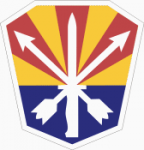
Нарукавный знак Объединенного штаба Национальной гвардии штата Аризона, СВ США
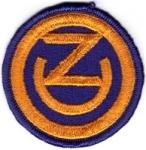
Нарукавный знак 102 учебной дивизии СВ США
Редактировать или перевести информацию
Description
A 2 1/4 inch (5.72 cm) overall square one angle up consisting of a 1 1/2 inch (3.81 cm) scarlet square bearing a white castle tower of three battlements and pointed at base paralleling the sides of the square on a 2 inch (5.08 cm) white square divided throughout by a 1/4 inch (.64 cm) wide scarlet saltire all within a 1/8 inch (.32 cm) scarlet border.
Symbolism
The colors scarlet and white are used for the Corps of Engineers, the castle tower being suggested by the Corps of Engineers branch insignia and its base pointed in reference to the Brigade’s combat requirements. The tower also represents the Headquarters of the Brigade and the white areas, simulating carpenter squares, grouped around it allude to the engineer combat and construction groups which it serves, the four areas specifically referring to the Headquarters basic mission of command, operational planning, operational supervision, and coordination of activities. The tower and white areas also simulate heavy construction (buildings, compounds, fortifications, bunkers, revetments, runways, roads, etc.) and on being placed on a square allude to the establishment of bases, the red border and the red saltire referring to lines of communication. In addition, the four white areas also resemble the letter “V” for victory (successful accomplishment) and the Roman numeral five (V) four of which make “20,” the numerical designation of the Brigade. A saltire is also the Brigade symbol used on maps.
Background
The shoulder sleeve insignia was approved on 30 June 1967. It was amended to add the blue and white “Airborne” tab on 14 January 1975. The insignia was amended effective 16 September 2009, to delete the airborne tab. (TIOH Drawing Number A-1-460)
A 2 1/4 inch (5.72 cm) overall square one angle up consisting of a 1 1/2 inch (3.81 cm) scarlet square bearing a white castle tower of three battlements and pointed at base paralleling the sides of the square on a 2 inch (5.08 cm) white square divided throughout by a 1/4 inch (.64 cm) wide scarlet saltire all within a 1/8 inch (.32 cm) scarlet border.
Symbolism
The colors scarlet and white are used for the Corps of Engineers, the castle tower being suggested by the Corps of Engineers branch insignia and its base pointed in reference to the Brigade’s combat requirements. The tower also represents the Headquarters of the Brigade and the white areas, simulating carpenter squares, grouped around it allude to the engineer combat and construction groups which it serves, the four areas specifically referring to the Headquarters basic mission of command, operational planning, operational supervision, and coordination of activities. The tower and white areas also simulate heavy construction (buildings, compounds, fortifications, bunkers, revetments, runways, roads, etc.) and on being placed on a square allude to the establishment of bases, the red border and the red saltire referring to lines of communication. In addition, the four white areas also resemble the letter “V” for victory (successful accomplishment) and the Roman numeral five (V) four of which make “20,” the numerical designation of the Brigade. A saltire is also the Brigade symbol used on maps.
Background
The shoulder sleeve insignia was approved on 30 June 1967. It was amended to add the blue and white “Airborne” tab on 14 January 1975. The insignia was amended effective 16 September 2009, to delete the airborne tab. (TIOH Drawing Number A-1-460)
Еще из категории: Инженерные войска
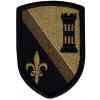 Нарукавный знак 225 инженерной бригады СВ США
Нарукавный знак 225 инженерной бригады СВ США
 Нарукавный знак 168 инженерной бригады СВ США
Нарукавный знак 168 инженерной бригады СВ США
 Нарукавный знак 30 инженерной бригады СВ США.
Нарукавный знак 30 инженерной бригады СВ США.
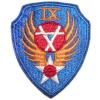 Нарукавный знак 9 командования инженерных войск СВ США
Нарукавный знак 9 командования инженерных войск СВ США
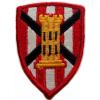 Нарукавный знак 7-й Инженерной бригады Сухопутных войск США
Нарукавный знак 7-й Инженерной бригады Сухопутных войск США



